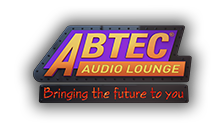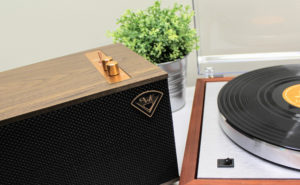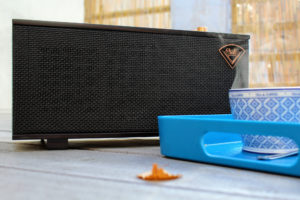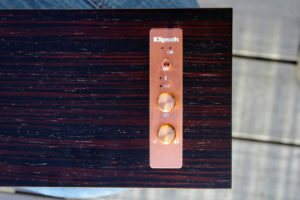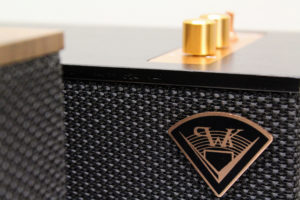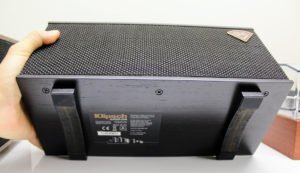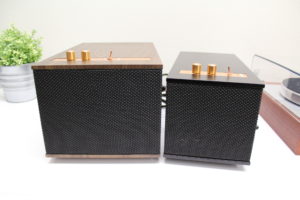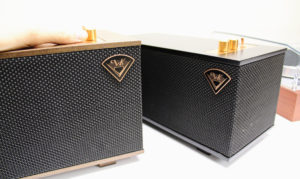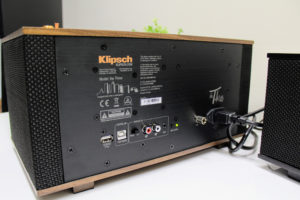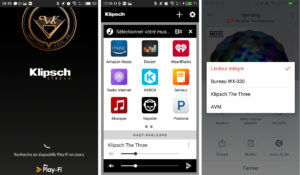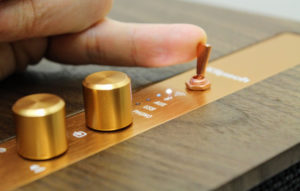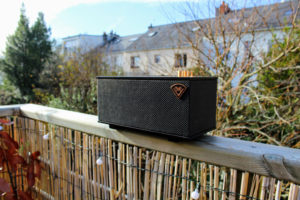We’ve recently tested Klipsch’s The One and The Three Bluetooth and WiFi speakers, the latest additions to the American manufacturer’s Heritage range. It thus comes as no surprise that the compact, portable Bluetooth speaker The One and its WiFi-enabled big sister The Three have inherited their esthetic codes from the Klipsch Heresy III speakers.
Klipsch The One: presentation
Klipsch’s The One speaker is equipped with a Bluetooth 4.0 receiver as well a line-level input to enable wireless playback (audio files, online radio programs, Deezer, Spotify, etc.) once paired with a smartphone, tablet, portable computer or even certain DAPs. According to the manufacturer, its integrated battery will provide 8 hours of musical enjoyment far from all sources of mains power on a single charge. So far, nothing out of the ordinary for a Bluetooth speaker.
At the heart of the speaker, meanwhile, a very unique set of components has been assembled. Klipsch has fitted this small speaker with two of its own full range drivers (2.25”), along with a 4.5” woofer and two passive drivers of similar dimensions. As a reminder, the passive drivers (installed along the sides of the speaker) act as resonators to naturally amplify the bass register (around 56 Hz). The speakers’ amplifier delivers 30 Watts RMS and can handle peaks of 50 Watts. Thus equipped, the Klipsch The One can produce a maximum sound level of 103 dB (at a distance of 1 m), from approximately 56 Hz to 20 Hz.
For a speaker measuring 32 cm wide, 15 cm high and 13 cm deep, the ability to reproduce such generous bass is extraordinary.
The Klipsch The One’s copper-plated control panel
The Klipsch The One and Klipsch The Three speakers proudly sport a vintage Klipsch logo bearing the initials of the brand’s founder, Paul Wilbur Klipsch.
Originating from the Heritage range, the Klipsch The One speaker’s enclosure is composed of MDF and its bottom and top panels are made of solid wood. Its remaining four panels are covered with black nylon acoustic cloth. A copper-colored metal plaque with two potentiometers (source selector and volume) and a power switch, all of which are also composed of metal, has been embedded into the speaker’s top panel. The Klipsch The One speaker handsomely shows that it means business.
Sparing no expense, the bottom panel of the Klipsch the One speaker is made of solid wood.
The Klipsch The Three on the left and the Klipsch The One on the right, both viewed from the side
Klipsch The Three: presentation
The WiFi-enabled Klipsch The Three speaker benefits from the same esthetic codes as its little sister, but to the wireless Bluetooth receiver it adds a WiFi controller, a phono preamp (for connection to a turntable with an MM cartridge) and a USB DAC (for computers). Without a battery, the Klipsch The Three has been designed for home use only. As it handles the DTS Play-Fi multiroom streaming technology, a smartphone or tablet with the Klipsch Stream app for iOS/Android may be used to listen to audio files and online music streaming services. Amazon Music, Deezer, Tidal and online radio stations may thus be directly accessed. Spotify is also handled, but on the condition that the online streaming service’s native app be used, and its Spotify Connect function enabled.
Larger in size, the Klipsch The Three integrates two 2.25” full range drivers, a 5.25” woofer and two passive drivers of similar dimensions. Its amplification system provides 60 Watts RMS (80 W in peaks), thus ensuring a maximum sound level of 106 dB (twice as intense as the Klipsch The One) along with a more extensive frequency response in the lows (45 Hz). The speaker’s structure remains the same, with the addition of a wider connection panel at the back.
The Klipsch The Three’s USB type B connector allows for connection to a computer (Mac, PC) and handles 24 bits/96 kHz audio stream
Klipsch The One & The Three: test conditions
We listened to the Klipsch The One speaker in our listening room (operating on mains power) and outside (operating on battery power), with Bluetooth connectivity enabled in both cases. As for the Klipsch The Three speaker, we also enabled its Bluetooth mode, but above all we used its WiFi function to listen to CD-quality as well as studio-quality FLAC files. The Klipsch The Three had no trouble with 24 bit/192 kHz audio stream. We used the Klipsch Stream app just as often as our Meizu smartphone’s built-in music player (DLNA playback).
The Klipsch Stream app, available for iOS and Android. Every DLNA-compatible audio player can stream music to the speaker.
Klipsch The One: listening impressions
As we had formerly been able to listen to one of the original Klipsch ProMedia 2.1 packs, we were well versed in the American brand’s approach, and while horn-loaded drivers weren’t on the agenda for these compact models, Klipsch has nonetheless outfitted its The One speaker with some perfectly serious, very well filtered drivers. The sound output and high-octane energy seemed like an anomaly for a speaker of this size. Its sonic profile combines robust and well-articulated bass frequencies with smooth and well-defined mids and highs. The Klipsch The One is a little firecracker which packs a lot more punch than the competition.
The Klipsch The Three’s control panel includes a power switch and 5 inputs to choose from
Klipsch The Three: listening impressions
The innate charm of the Klipsch The Three is difficult to resist, as this speaker delivers crystal-clear high-mids and outstandingly deep bass. It dives deep, gives justice where justice is due, and never gets muddy–in short, it’s simply full of life. The highs are brought farther forward than with the Klipsch The One, but we can’t complain, as the result is rewarding. The listening experience is delightfully enhanced with extra character and breadth. In our listening room, the Klipsch The Three produced more bass than the majority of speakers we’ve tested as of late. Which goes to say that it is capable of providing endless hours of enjoyment!
Klipsch The One & The Three: conclusions
What we liked: the vintage design, the finish quality, the solid bass delivery, the energy
What we would have liked: a WiFi controller for the Klipsch The One, an optical input for the Klipsch The Three
Two excellent WiFi and Bluetooth speakers, one capable of churning out high-quality sound on the terrace and the other able to fill a 50m2 living room, with both being as enjoyable at low volume as they are at maximum volume. The Klipsch The One stays more neutral, but it’s the Klipsch The Three which is the most attractive offer, thanks to its joyful and authoritative performance in Bluetooth or WiFi mode or via the line-level input. Indeed, the Klipsch The Three outperforms models sold for twice its price.
Read more at: http://blog.son-video.com/en/2016/12/review-klipsch-the-one-klipsch-the-three/
Where to buy Klipsch: https://www.abtec.co.nz/product-search.php?keyword=Klipsch+Heritage&category=&brand=&search=
